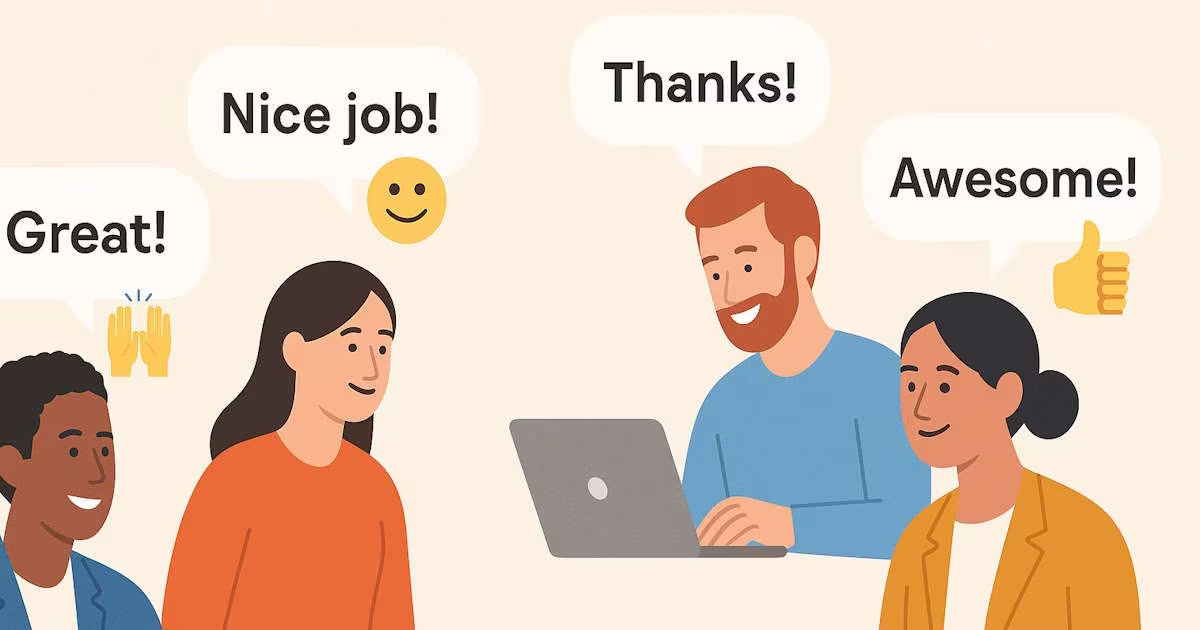
Micro-Recognition: The Small Kudos That Make a Big Impact
Why Small Recognition Matters More Than You Think
In a world of sprint deadlines, Slack pings and last-minute bug fixes, it’s easy to assume recognition has to be big to be meaningful—think awards, bonuses, or lengthy appreciation posts. But in high-performing Agile teams, the most powerful appreciation often comes in the smallest packages.
This is the power of micro-recognition: quick, informal kudos that keep momentum and morale high. If you want a simple structure for giving meaningful appreciation, you can learn more about how kudo cards work.
Sometimes all it takes is a "Nice catch, thank you 🙌" to shift someone’s entire day. That little moment might feel like nothing to you—but it could be everything to them.
What Is Micro-Recognition?
Micro-recognition is the art of showing appreciation in the moment—briefly, informally and with sincerity.
It’s the:
- 👏 You drop in Slack when someone fixes a blocker.
- ✨ Shoutout during stand-up for a teammate’s extra effort.
- 👍 PR comment acknowledging great code readability.
- 💬 Two-second "thank you" after a last-minute save.
Unlike formal recognition programs, micro-recognition is:
- Instant
- Contextual
- Peer-driven
- And most importantly—habitual
It’s not about ceremonies. It’s about creating a culture where people feel seen without needing a reason to throw a party.
Why Micro-Kudos Work (Especially in Agile Teams)
Agile teams thrive on continuous feedback, fast iteration and strong communication. Micro-recognition aligns perfectly with all of that:
✅ Frictionless & Fast
It doesn’t require a meeting or approval—it happens in real-time, where the work is happening.
✅ Immediate Reinforcement
The best recognition happens right when the action occurs—it reinforces the behavior immediately.
✅ It Spreads Peer-to-Peer
Unlike top-down praise, micro-kudos flow between team members, building trust horizontally, not just hierarchically.
✅ Builds Psychological Safety
Small, consistent moments of appreciation make it safe to speak up, take initiative and share ideas.
And the science backs it up: recognition—especially timely, specific and personal—triggers dopamine and serotonin, which are directly linked to motivation, learning and mood.
Real-Life Micro-Kudos That Matter
Need inspiration? Here are some kudos that take less than 30 seconds to give—but make a lasting impact:
"Thanks @sophie for hopping on that call with the client—total lifesaver 🙌."
"Shoutout to Arjun for simplifying that endpoint—made integration way smoother."
"Nice call on adding test coverage for that edge case. It caught a nasty one 👏."
"Sarah’s story handoff was the clearest I’ve seen. Super helpful!"
Notice the pattern?
They’re all:
- Timely
- Specific
- Positive
- Peer-oriented
That’s the recipe.
How to Make Micro-Recognition a Habit in Your Team
The magic of micro-kudos is in their frequency—not their formality. Here's how to embed it into your team rhythm:
🔹 Add a kudos moment to stand-ups or retros
It only takes one minute—and it's a great energy booster.
🔹 Create a #kudos Slack or Teams channel
Let teammates drop informal thanks and shoutouts throughout the week.
🔹 Lead by example
If you’re a team lead or Scrum Master, model the behavior. Others will follow.
🔹 Use a tool like esteam.life
Make giving and tracking kudos seamless—especially in distributed or asynchronous teams. If you prefer structured messages that still feel personal, check out what kudo cards are.
If you want a quick way to choose a visual style that fits the moment, take a look at our kudo card templates.
Micro-recognition works best when it’s visible, voluntary and valued. Make it easy and it becomes automatic.
Micro-Kudos = Macro Impact
Here’s the thing: team culture isn’t built on off-sites or quarterly reviews. It’s built in the small, daily moments where people feel seen, heard and appreciated.
Recognition doesn’t have to be dramatic to be meaningful.
- A small thank you today reinforces collaboration tomorrow.
- A 5-second Slack shoutout could be the nudge someone needs to take initiative again.
- A peer kudos in a retro might be remembered longer than any Jira ticket.
Micro-recognition isn’t a perk. It’s infrastructure. It’s the social glue that binds high-trust teams.
Start Small—Start Today
You don’t need a complex recognition program. You just need to start saying things like:
"Hey, I noticed. Thank you."
So try it today:
✅ Send one piece of appreciation
✅ Make it specific, timely and real
✅ Watch how it shifts your team’s energy
If you want to go a step further and make recognition easier to repeat, you can explore how kudo cards fit into micro-recognition. And for teams who want appreciation to become a habit—not just a good intention—check out esteam.life. We help Agile teams build a stronger, more appreciative culture—one small kudos at a time.